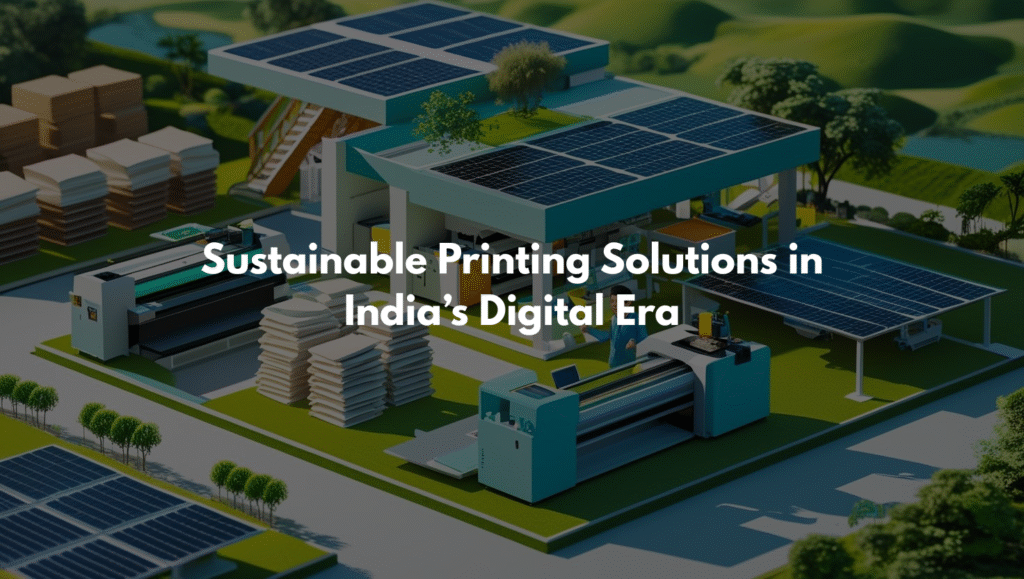
Mumbai, May 28, 2025 — India’s printing business, worth USD 27.5 billion and expected to grow at a 5.8% CAGR until 2030, is adjusting to the digital age with sustainability transforming the game.
Paced by green regulations, buyer pressure for environment-friendly products, and reducing carbon footprints, soy-based, water-based, and energy-efficient inks are gaining popularity.
These green printing solutions are in line with India’s green agenda, complementing efforts such as the National Green Mission, but the cost and technicality of change risk undermining take-up, especially among smaller businesses.
The move to sustainable inks is part of a wider effort to reduce the environmental footprint of printing, which represents 15% of India’s packaging industry and underpins its USD 1.5 trillion retail economy.
Regulatory environments such as the Bureau of Indian Standards (BIS) and the Plastic Waste Management Rules, 2016, require low VOC emissions and recyclables. Internationally, regulations such as the EU’s REACH limit hazardous chemicals in inks, which affects India’s USD 2 billion printing export industry.
Consumers are changing their preferences too, with 70% of city dwellers preferring green packaging, as per a 2024 Nielsen survey, stimulating demand for green inks in publishing, packaging, and business printing.
Soy-based inks, which are made from soybean oil, are at the forefront. With rich color and biodegradability, these inks lower VOC emissions by 80% over petroleum-based options, as per a 2024 FICCI report.
Firms such as DIC India, a leading ink supplier, have brought out soy inks for offset printing, employed in FMCG packaging, with 20% improved drying time and 15% reduced energy consumption. In Tamil Nadu print clusters, soy inks reduced waste disposal expenses by 25%, favoring small-scale printers.
Though soy inks are more expensive—20% more than traditional inks—curbing uptake in MSMEs, which command 40% of the market.
Ink that contains water as the main solvent is becoming increasingly popular in flexographic and gravure packaging printing, especially for food packaging. Water-based inks, that have been embraced by companies such as UFlex, do away with harmful solvents, passing BIS’s low-VOC tests and REACH’s no-added-formaldehyde regulations.
A recent 2023 IIT Bombay report discovered that water-based inks lower emissions by 90% and sustain adhesion on plastic substrates, so vital to India’s 8% per annum packaging expansion.
Their water resistance, due to additives of nanocellulose, facilitates use in humid environments. However, slower drying rates and the requirement for specialty presses hinder high-speed usage.

Low-energy inks for UV and LED-curable systems are revolutionizing digital printing, which represents 30% of India’s printing business. These inks, from HP India’s Indigo presses, instantly dry under LED light, reducing energy use by 50% from conventional UV systems, according to a 2024 CII report.
Low-energy inks in Bengaluru’s commercial printing centers have lowered costs of operations by 18%, improving profitability. Their support for recyclable substrates also conforms to the Extended Producer Responsibility (EPR) system, promoting greener packaging.
But the initial high price of LED-curable presses, ranging from Rs. 50 lakh and more, discourages smaller printers.
Performance gaps are being bridged through innovations. Pigments made from algae and plant extracts are improving color intensity in soy and water-based inks to match petroleum-based excellence.
At an industry expo recently, Siegwerk displayed hybrid inks blending soy and water-based performance, delivering 95% biodegradability and a 30% reduction in production emissions. Nanotechnology, such as in graphene additives, enhances the durability and conductivity of ink for printed electronics, a market expanding at 12% every year.
These technologies align with India’s aspirations to decrease industrial emissions by 45% by 2030 under the National Green Mission.
Government policies are driving adoption. The Production-Linked Incentive (PLI) policy encourages R&D on green inks, with Rs. 50,000 crore being dedicated to the National Research Foundation (NRF) for industry-academia partnerships.
The Raising and Accelerating MSME Performance (RAMP) program assists small companies to adopt environment-friendly technologies. The Skill India Digital Hub has skilled 2 million workers on advanced printing since 2023, enhancing implementation. Swachh Bharat Mission encourages recyclable, driving packaging demand for eco-inks.
Challenges remain, however. Sustainable inks cost 20-30% more than conventional options, limiting MSME adoption to 12%, per a 2024 SIDBI report. Technical limitations, like water-based inks’ sensitivity to humidity, require process adjustments, delaying projects in monsoon-prone regions. Skill shortages, with just 5% of the workforce trained in eco-ink applications, per Nasscom, hinder innovation. Infrastructure challenges, such as unreliable power in Tier 2 cities, hobble digital presses, amounting to Rs. 1-2 lakh per month for SMEs, as reported in industry chatter. Smaller printers’ low awareness, focusing on cost rather than sustainability, hamper progress.
Experts suggest focussed intervention. Subsidies under the Technology Upgradation Scheme can help recover costs. Scaling up Skill India’s skill training in green printing can fill the skills gap.
Enhancing 5G connectivity and power quality, as envisaged under PM Gati Shakti, will aid digital printing. Public-private collaborations with IITs can ramp up R&D to make cost-effective inks available.
CII-initiated campaigns for awareness can generate demand in niche markets, leading to inclusive growth.
India’s printing industry is going green with inks of conscience, bucking the international trends in a digital era. Supporting an ink market worth USD 3 billion by 2030, soy-based, water-based, and low-energy inks are the drivers of environmentally friendly operations.
Overcoming cost, skill, and infrastructure hurdles, Indian manufacturers can drive the transition to sustainable printing, without sacrificing profit for a cleaner future.
